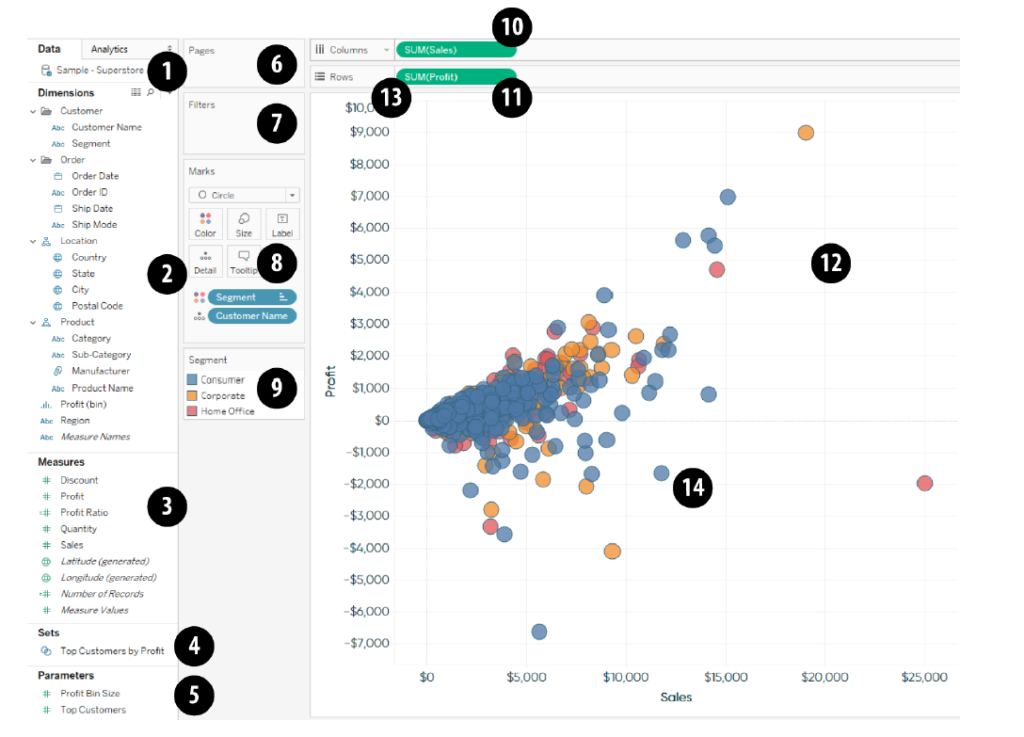In this article, I am going to share one of the famous and required for each and everyone who is working in the analytics field mainly in the Business Intelligence area. If you are preparing your career in BI development or Tableau Interview or data analyst interviews, then this article is cream for you guys!
If you are learning Tableau as a visualization tool or reporting tool, Then you should know these terms which are used continuously, and each and every second you will be dealing with these terms.
You must know below terms before start Tableau:

So, your tableau worksheet will look like above image except the chart profit vs sales will not be there. But the architecture will be the same.
Let us discuss one by one terminology:
- Dataset: This is the data source that is connected. If you right-click on this dataset name you can see different options to refresh the data, extract the data, and many more.
- Dimensions: This section will contain the attributes name of data. Dimensions are the data fields that we cannot be aggregate, or we can’t sum or divide or subtract. The data which has String, Date data type mostly comes under this section. E.g., customer name, state, date, city, etc.
- Measure: This section contains the numerical data on which I can do many aggregations as well as numerical calculations like sum, minus, divide, multiplication, etc. e.g., Sales, Profit, Discount, etc.
- Sets: Sets in Tableau are dynamic groups of data. Data can be updated if refreshed. This section will contain only sets created in tableau.
- Parameters: In this section, the parameters will get added if created in tableau. Parameters are the user-defined filters where data can be changed dynamically, but a single value selected.
- Pages shelf: If you dragged any dimension into the pages shelf, then you can see that dimension in flips or different switches of data. If you want to create a motion chart with some transitions, then the pages shelf can be helpful.
- Filters shelf: Filters are basically used for data restrictions. If I want to take limited data inside tableau or in sheet then I can apply a filter on that field or just drag that field into filters shelf.
- Marks card: Marks cards are used for data level of detail showcase in charts or views as well as to format the sheet with respect to color, detail, size, shape, label, tooltip, etc.
I will explain the use of each and every card in marks card in my upcoming article.
- Legends: Legends are useful to see the exact differentiation of data or exact contamination of the data in the view.
- Columns shelf: If you drag any field into the columns shelf, it will create X-axis in the view.
- Rows shelf: If you drag any field into the Rows shelf, it will create Y-axis in the view.
- Workspace: Workspace is the space where I can build or visualize my charts or graphs or visuals.
- Pills: Pills means the data dimensions or measures used to create a chart. It can be either green or blue. Green when continuous field and blue when discrete field.
- Chart or view: The data is distributed along the x-axis and the y-axis is the view.
- Show me section: click to read detailed information.
This article is most to understand the basic terms used in daily life while dealing with Tableau.
I hope you have enjoyed reading this article and happy to learn my next blogs. I hope you will start learning Tableau and getting prepared for your interview with some basic content. The above terms will help you to understand the extract of the tableau and prepare for the interview.
Have you found these basic concepts helpful? Please comment and let me know what you think.
TableauwizTrupti
Thank you!!!
If you are preparing for tableau interview Please check my latest articles below:
Recently asked Tableau Interview questions
How to explain Project in interview?
How to explain domain specific KPIs?
Day to day responsibilities in working company
I hope you enjoyed reading article.
Pingback: Show me Section in Tableau... - IT-Gurukul